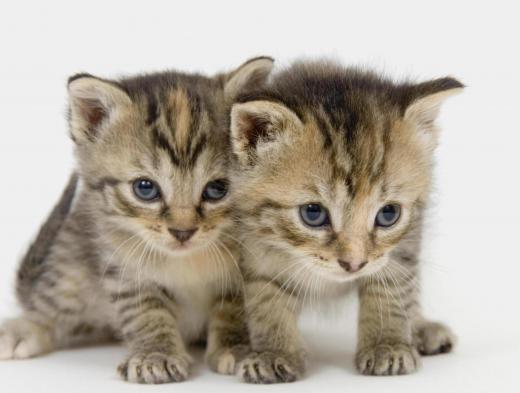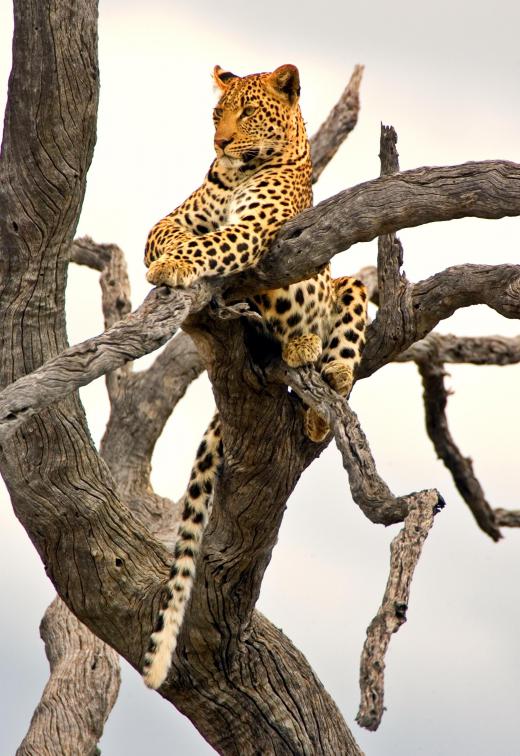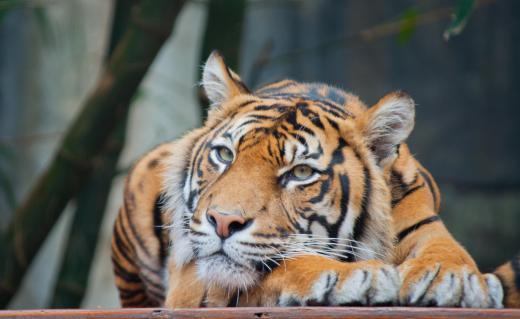What are Felids?
 Michael Anissimov
Michael Anissimov
Felids are members of the biological family Felidae, the broader family of cats. The family includes two subfamilies, Pantherinae, also called the "big cats," (lions, tigers, jaguars, leopards), and Felinae (cougars, cheetah, lynxes, the caracal, and the familiar Domestic Cat). Felids evolved during the Oligocene, approximately 25 million years ago. Up until just about 10,000 years ago, there was another subfamily of cats, the Machairodontinae, which included the famous saber-toothed cats, but they were probably driven to extinction by humans.
Today, there are 40 species of felids, all thought to have descended from a common ancestor that lived about 10.8 million years ago. This group evolved in Asia and spread throughout the world via land bridges. At least 10 distinction migrations occurred. Like many taxa of placental mammals, the natural range of felids includes all continents except for Australia and Antarctica. Felids are usually not found in small islands far from the coast unless introduced by humans.

As members of Order Carnivora, felids are meat-eaters, but even more specially adapted for hunting and meat-eating than any other family within the order. Felids require meat to live, as the parts of their intestine capable of processing vegetative matter have long been selected out. Felids mainly subsist on the consumption of other vertebrates, including birds, rodents, and larger animals like gazelles, deer, elk, bighorn sheep, and wildebeest. Three-quarters of cats live in forested terrain, where they climb trees and act as ambush predators. Except for lions and the Domestic Cat, all felids are solitary.

Felids are extremely skilled hunters. Except for the cheetah, they have retractable claws, which lets them walk easily but extend their claws when going in for the kill. They possess large eyes with excellent night vision, provided in part by the tapetum lecidum, a reflective membrane inside the eye that helps direct light onto the retina under low-light conditions. This is what causes the characteristic eyeshine of felids. Because of their eyeshine, felids can be found easily at night by humans shining a flashlight and looking for the characteristic reflective eyes.

The most successful of the felids in terms of numbers is of course the Domestic Cat, which have spread throughout the world as human pets and vermin-killers. Cats are the world's most popular pet, with a population approaching one billion. The relationship between humans and cats goes back at least 9,500 years, maybe more. Through thousands of years of selective breeding, there are now about 73 distinct breeds of cats.
AS FEATURED ON:
AS FEATURED ON:

















Discussion Comments
I have a cat who is pretty spoiled and has become an indoor/outdoor cat. She wants to be outside most of the spring, summer and fall, but as soon as the temperature begins to get colder, she wants to be inside most of the time.
Because of this, she still has her front claws. This is important for her to be able to defend herself if she needs to.
Once when I was watching a friends dog for the week, my cat made sure to let the dog know who was boss. It didn't take more than once to feel those sharp claws on his nose to leave the cat alone.
I have always had cats, and love to hear them purr. I think that is the sign of a contented cat, because they always purr when they are happy. I have never heard a cat purr when it is upset at something.
This always makes me wonder if tigers and lions also purr, or if that is just something that domestic cats do. I have a male cat who purrs very loud and you can easily hear him across the room. I can only imagine how loud a tiger or lion would purr.
I am always intrigued by the similarities of my domestic cat and tigers and lions that I see at the zoo or on television.
They are on full alert by anything that moves. Even if I am dragging a limb across the yard, my cat is watching and ready to pounce. She is an excellent hunter and is very patient when it comes to stalking her prey.
I have received a wide assortment of "gifts" on the doorstep including birds, rabbits and mice. Even though that is pretty gross for me, I realize that is their instinct, and if she was on her own, that would be how she would survive.
I like to watch domestic cats hunt. They are so methodical and careful. I once saw my neighbor’s cat stalk a rabbit bigger than it, and the cat came very close to snatching it.
The cat saw the rabbit from about thirty feet away. It was munching grass at the edge of the woods. Immediately, the cat flattened itself into the grass. Every time the rabbit would look away, the cat would slide a few steps forward. As soon as the rabbit turned its head again, the cat would freeze.
This went on for about 20 minutes. I admired the cat’s patience. Unfortunately, another cat saw the same rabbit and messed up the plan. The rabbit saw the second cat and took off into the woods.
Unlike several people I know, I have never had the desire to go on a safari. I don’t want to get anywhere near Africa because of the variety of felids dwelling there. I know that I don’t stand a chance against these muscular, clawed, toothy beasts, and I find it hard to believe that anyone would want to get near them.
I used to be fascinated with leopards. Though a safari did not appeal to me, I once entertained the idea of encountering a tame one with a trainer present, until I read that they love to eat dogs. I am a dog person, and I cannot remain a fan of something that wants to do them harm.
My family took in a stray cat, not knowing that she was pregnant. She had a litter of five, and I mistakenly believed we would get to keep them all.
Since my sister and I both had allergies that were made worse by cat hair, my parents decided to get rid of the cat and the kittens. I was very sad until my parents told me that a nice man wanted to keep them on his farm to get rid of the mice in the barn. They said the cats would have freedom to roam and play all they wanted.
My parents never had any of our cats declawed, because they had to be outdoor cats. I am allergic to them, but I can tolerate them if I don’t have to deal with their hair in the house all over everything.
I loved cats as a child, but I loved to play a little too rough. One cat used the claws we let him keep to let me know that I had crossed the line.
I was only four years old when I picked up our big yellow cat and started spinning him through the air with his legs outstretched. He quickly sank his claws into my abdomen and held on tightly, even after I tried releasing him. I had to scream for my mother to come and extract him from me.
@JaneAir - That is funny. You must really love your cat!
I'm always amazed at the similarities between domesticated cats and their wild brethren. While we think of cats as our furry little friends, they are quite vicious hunters when they get the chance.
When I was younger, my good friends cat used to go outside and kill things and bring them back for the family. Gross, but it was the cats way of showing he cared. I saw on a documentary when cats do this they think they are feeding you! It is really kind of sweet in a yucky way.
I've always been amazed at the excellent night vision cats possess. However, I somehow wasn't always aware of it.
When I got my cat in high school, I didn't know cats could see so well in the dark. My cat wasn't allowed upstairs into the bedrooms, so he spent all night by himself downstairs. I used to sneak down and turn a light on for the cat so he wouldn't have to sit in the dark. Little did I know the cat could see fine without the light!
I always laugh at this a little bit. However, I'm sure our power bill would have been a lot less if I wasn't sneaking around turning lights back on.
Post your comments